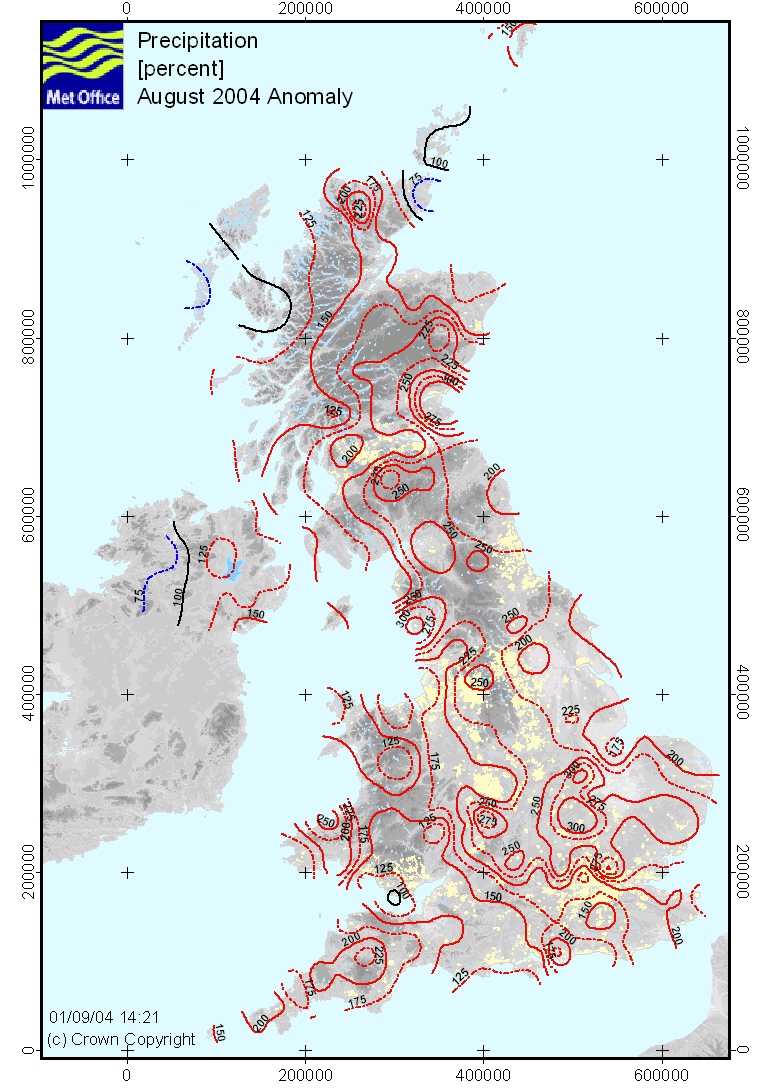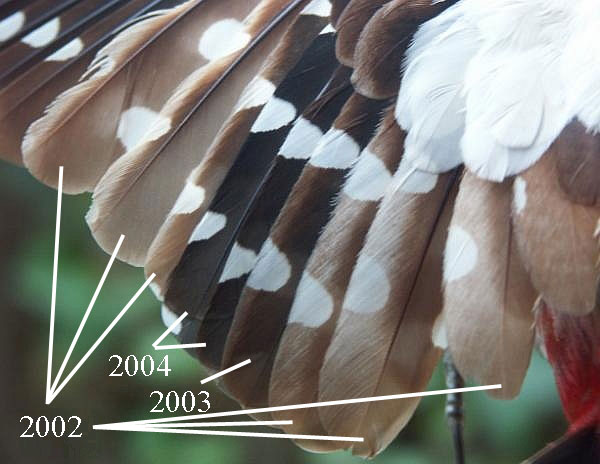Seasonal, and unseasonal, offerings (7 January 2005)
Several previous postings to these pages have shown birds that have undergone more extensive moults than normal. There are some individuals at the other end of the range, having renewed very few feathers in their post-juvenile moult. A Greenfinch Carduelis chloris ringed on 13 October 2004 was unusually late in its moult and was aged as a Euring 3J (a first-year bird still with some juvenile feathers). It is still moulting from its juvenile plumage, having some juvenile (streaked) breast and neck feathers:
.jpg)
On its wings it looks as if it is retaining all of its juvenile greater coverts, carpal covert and alula, and is actively moulting just one median covert, the feather emerging from its sheath just to the right of my thumb in the picture below. This is a very un-extensive degree of post-juvenile moult and probably explained by the late date:
.jpg)
Similarly, a Song Thrush Turdus philomelos ringed on 28 November 2004 was an unusual bird, a first-year with entirely juvenile greater coverts and its moult limit half-way through its median coverts. Apologies that the photograph (below) is not very high quality because it was taken indoors with flash, the bird having been caught at dusk coming into roost.
.jpg)
Jenni and Winkler (Moult and Ageing of European Passerines, Academic Press, 1994) give figures for their sample of 1103 Song Thrushes ringed in Switzerland, of which 0.8% had not moulted any greater coverts. But Jenni & Winkler state that median coverts are 'usually all moulted ... (but) birds with no greater covert moulted may retain individual juvenile median coverts': the bird shown above is unusual in having retained so many juvenile median coverts.
Another Song Thrush with an identical moult pattern was caught on 19 December 2004 at the same site, and could have been a sibling. I suspect that these are late-hatched birds from a species with a very extended breeding season. Jenni & Winkler show (their Fig. 289) a reduction in the mean number of moulted greater coverts as the migration season goes on, presumably backing up the point about later-hatched birds having less extensive moult.
The contour map from the UK Meteorological Office (http://www.met-office.gov.uk/climate/uk/2004/august/maps/Rainfall_Anomaly%20No%20Stations.jpg) shows that the August 2004 rainfall was two or three times the long-term average for the month across most of Britain. Birds like thrushes that feed on soil invertebrates (worms, slugs, snails etc) had an easy time of finding food in the wet soil and some of them took advantage by having a late brood.

In another example of how some features of birds' biology can translate across thousands of miles, the limited moult of these Song Thrushes is almost identical to that exhibited by one of their close relatives, the American Robin Turdus migratorius caught on 10 November 2004 by my good friends at Powdermill Nature Reserve, Pennsylvania, USA, and depicted on their website.
A seasonal tone to this Christmas/ New Year page is brought by a Mistle Thrush Turdus viscivorus, whose common name and scientific name both come from its longstanding habit of eating berries of Mistletoe Viscum album. Nowadays, however, they are much more likely to be found defending a large bush of holly Ilex aquifolium.
.jpg)
This bird was a first-year, Euring age code 3, shown by its moult limit in the greater coverts, with four 'old' (juvenile) feathers.
.jpg)
Not many of us in Britain gain familiarity with ageing Mistle Thrushes, as relatively few are ringed - only around one-hundredth of the numbers of the commonest thrush, the Blackbird Turdus merula - but, as well as the difference in colour and texture between the two generations of feathers in the greater coverts, there is also the obvious step in size, usually found with thrushes. We should, however, beware of oddities such as the Robin Erithacus rubecula shown below. Both the step in size from the innermost four greater coverts to the outermost six, and the lighter-coloured spots on the tips of three of the outermost greater coverts, could fool the unwary ringer into thinking this is a first-year bird but in fact it was ringed two years ago. As pointed out previously, it is certainly not true that the presence of any buff tips has to indicate a first-year Robin. The buffish shaft on the outermost median covert might also have been designed to mislead us! But the colour and texture (glossiness) of the greater coverts is the same, and I guess that the step in size just has to be explained-away as an oddity.
.jpg)
This website is not supposed to be a 'freak show', but some strange plumages demand attention and comment. The Great Spotted Woodpecker Dendrocopos major shown previously just over a year ago (18 December 2003) was retrapped in my garden on 11 December 2004, and has still not moulted some of its feathers, although others have been renewed normally.
.jpg)
Hatched in 2002 or earlier, this bird is now at least two-and-a-half years old, and in its annual moult in 2004, as in 2003, it missed replacing many of its feathers, which are now bleached and pale, but still serviceable! The old feathers on top of its head give it a distinctly odd look:
.jpg)
On the other hand, it has moulted a new tail, some primaries and some secondary feathers. Comparison with photographs from December 2003, and the detailed moult card completed then, shows that most of the secondary feathers were not moulted normally in 2003 and thus are now at least two-and-a-half years old, and clearly appear to be very bleached, although not badly worn. The image is annotated with the year in which the secondary feathers were grown; the contrast between the generations of feathers is striking:

One would have thought that a bird looking like this must be in trouble, with some physiological malfunctions, but it has clearly survived to a reasonable age. It might also be expected to be in poor condition, so what about the traditional measure of condition, the bird's weight? Who would have guessed that its weight was identical, to within 0.1g, to when it was first ringed a year ago, and that this is actually the heaviest Great Spotted Woodpecker (87.8g) that I have ever measured in 25 years of ringing?
David Norman.